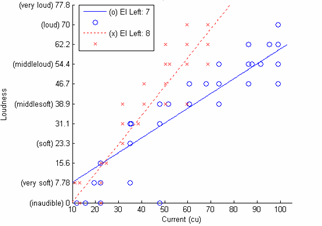Binaural Loudness Scaling with Cochlear Implant Listeners (LoudSca)
Objective
The dependency of perceived loudness from electrical current in Cochlear Implant (CI) stimulation has been investigated in several existing studies. This investigation has two main goals:
- To study the efficiency of an adaptive method to determine the loudness function.
- To measure the loudness function in binaural as well as monaural stimulation.
Objective
The dependency of perceived loudness from electrical current in Cochlear Implant (CI) stimulation has been investigated in several existing studies. This investigation has two main goals:
- To study the efficiency of an adaptive method to determine the loudness function.
- To measure the loudness function in binaural as well as monaural stimulation.
Method
Loudness functions are measured at single electrodes (or interaural electrode pairs) using the method of categorical loudness scaling. The efficiency of this method for hearing impaired listeners has been demonstrated in previous studies (Brand and Hohmann, JASA 112, p.1597-1604). Both an adaptive method and the method of constant stimuli are used. Binaural functions are measured subsequently to monaural function, including monaural measurements as control conditions.
Application
The results indicate the suitability and efficiency of the adaptive categorical loudness scaling method as a tool for the fast determination of the loudness function. This can be applied to the clinical fitting of implant processors as well as for pre-measurements in psychoaoustic CI studies. The measurement results also provide new insights into monaural and binaural loudness perception of CI listeners.
Funding
internal
Publications
- Wippel, F., Majdak, P., and Laback, B. (2007). Monaural and binaural categorical loudness scaling in electric hearing, presented at Conference on Implantable Auditory Prostheses (CIAP), Lake Tahoe.
- Wippel, F. (2007). Monaural and binaural loudness scaling with cochlea implant listeners, master thesis, Technical University Vienna, Autrian Academy of Sciences (in German)
